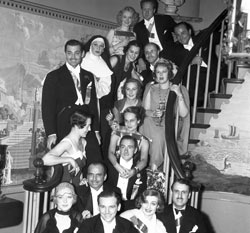May 2010
She had incredible resources and graceful race horses. But young Joan Whitney Payson’s true talent was unearthing overlooked masterworks by the likes of Picasso, Monet, and Cézanne. Travel with her as she crisscrosses the globe in search of fulfillment of her passion.
By Colin W. Sargent

Now that the controversial documentary The Art of the Steal has the NPR set abuzz by shining the spotlight on art aficionado Albert C. Barnes and what’s happened to his collection since his death, it may well be time to revisit the colorful life and times of our own flapper/collector, Joan Whitney Payson (1903-1975).
Dr. Barnes acquired his first Picasso in Paris for less than $100, but Joan received her first painting as a gift.
PLANTING A SEED
At her 16th birthday party at the Whitney family’s estate, earned with banking and railroad money, Joan untied the twine on a parcel wrapped in brown paper. The debutante, known for her bouncy disposition and short curls the color of champagne, was enchanted. As the celebration raged on, she couldn’t take her eyes off Degas’s Children and Ponies in a Park, 1868. She was hooked.
“She and her mother, Helen Hay Whitney, had seen it…” says Carrie Haslett, director of exhibitions and academic programs of the Terra Foundation for American Art in Chicago, “…at a New York auction house,” another source familiar with the matter tells us. “She fell in love with it. Her mother, as an absentee bidder,” planned that surprise.
Dark and dreamlike, the painting charms with mystical woods that provide an almost supernatural background for three young girls frolicking with two ponies and a burro among what appear to be irises. Most satisfyingly, the animals are in eternal balance: one coming, one going, the burro demonstrating his unpredictability and freedom by defiantly lying down, catching the viewer’s eye. At the run, a white lamb rushes in to join the fun.
It’s the ne plus ultra answer to the question, “What do you give a horse-loving girl who already has a horse?”
This study by Degas, never intended for public viewing, was the launch of Joan’s evolving passion to collect not simply paintings as objets d’art or investments, but to capture and preserve the very intimate feelings she had for them as talismans able to conjure up adventures and memories in her own life. From the beginning, Haslett says, “her collections were very personal.”
But was she truly ahead of her time in buying up Impressionist and Post-Impressionist works for a song?
“Her whole family was amazing in terms of its support of the arts,” Haslett says. And while Joan’s collecting “wasn’t singularly avant-garde among the upper classes, it is distinguished in its quality.”
Certainly, Joan risked offending the stodgy tastes of those who championed the sentiments of Royal Cortissoz, the popular critic who dismissed modernism as a “Post-Impressionist illusion.” Many a bejeweled hand in Newport’s seaside castles still clung to renderings of sailboats, horses, and murky Grand Tour subjects by masters like Titian, Tintoretto, or, more likely, works done “after the manner of” those giants.
| The Sisterhood of the Traveling Painting
Vincent van Gogh’s Les Iris stuns as no other painting can. According to Wikipedia, Theo van Gogh wrote to his brother Vincent: “‘[It] strikes the eye from afar. The Irises are a beauty study full of air and life.’” While painting it, Vincent (1853-1890) called it “‘the lightning conductor for my illness.’’’ While Wikipedia reports the first owner to be novelist, “French art critic, and anarchist Octave Mirbeau, who was also one of van Gogh’s first supporters,” Scott Allan of the J. Paul Getty Museum has generously provided us with documents to support the following provenance for the masterpiece that “represents a patch of garden in the asylum at Saint-Rémy, where van Gogh took refuge from May 1889 until May 1890 following his breakdown at Arles.”* 1889–painted by Vincent van Gogh (Saint-Rémy-de-Provence, France) *For provenance in greater depth, our source is Jennifer Helvey’s Irises: Vincent van Gogh in the Garden, The J. Paul Getty Museum, 2009 |
NOT OUR JOAN!
And yes, young Joan traveled in those circles, spending summer visits at The Breakers, the pharaonic summer “cottage” built on the Newport oceanfront for railroad plutocrat Cornelius Vanderbilt.
More specifically, if you tour The Breakers, the guide might allude to one of the upstairs bedrooms as the place where “little Joanie Whitney used to stay when she visited here.”
“I’m surprised they tossed that in there,” Joan’s son John Whitney Payson has told us [Summerguide 1996]. “Of course, her aunt was Gertrude Vanderbilt Whitney, so she might very well have visited there as a young girl.”
Clearly, this was a far different ingenue than the dowager empress local Falmouth Foreside residents would claim to remember decades later from various interludes at her place here on Mussel Cove on Route 88, the summer Mainer entombed inside the sports-trivia chestnut that she single-handedly founded a little baseball team we like to call the New York Mets (her husband, Maine native Charles Shipman Payson, apparently didn’t remotely share her interest in, and involvement with, the team).
No. This Joan was a tiara-wearing extrovert who was eminently capable of traveling in fast company that included (see our opening photo) Clark Gable, Marion Davies, Douglas Fairbanks Jr., Carole Lombard, Countess Di Frasso (didn’t they all lust for the royal titles), and Prince Serge Obelenski.
THE RIGHT DEALER AT THE RIGHT TIME
And young Joan was not at all shy about practicing the art of the deal, especially during her many trips to Europe.
As John Whitney Payson has told us, “Le Favre was one of my mom’s favorite galleries. Francois Dolt told me that Carman Messmore [the famous New York art dealer and chairman of Knoedler & Co.] took her to see Madame Marquet, widow of Albert Marquet, whose paintings she collected. It was five floors up, but if my mother wanted to get somewhere, she’d get there. After a while, she used the powder room and saw that Albert Marquet had hand painted many of the tiles. She came out of there and tried to buy the powder room!”
How influential was Carman Messmore on Joan’s evolving taste? As Messmore’s granddaughter, Madelaine Messmore-Netter, says, “He didn’t impose his own taste on his clients. He helped them discover their own. Here’s an example of how he worked. I was in my early twenties when I was invited to attend a cocktail party with my grandparents in New York. My grandfather, who was in his nineties, took me aside and drew my attention to a woman in her mid-seventies. ‘I want you to sit beside her at dinner,’ he said. ‘See how beautiful she is. Look at how her eyes are set back. Look at the lines on her face. Look at her jaw line and her lovely neck.’
“It was about learning to look at things.”Up close, Messmore-Netter felt swept away.
“He had a great way of making you see through to the truth.” Just as mesmerizing was his gift for making his clients feel an intense excitement for being alive.
ARTISTIC SIBLING RIVALRY
As the seasons passed, Joan began an informal acquisition competition with her younger brother, John Hay “Jock” Whitney (who would go on to amass a collection of over 70 paintings by 19th- and 20th-century European and American masters and serve as a National Gallery trustee from 1961 to 1979), though the way brother and sister went about it was as different as night and day:
“Jock is highly recognized as a collector, and he sought that,” Haslett says. “Of course, it’s not bad for visibility when you’re publisher of the New York Herald Tribune and U.S. Ambassador to England. I think the best man at his wedding was [Robert C. Benchley, with one of the groomsmen] Fred Astaire.”
In contrast, “hers was this personal collection, quietly assembled.”
Just as Albert Barnes’s treasure trove (rarely viewed until the late 1960s) bloomed, so did Joan Whitney Payson’s private collection grow–in the shade.
SOUVENIRS OF HER TRAVELS
•Which leads us to Irises. When Joan purchased this painting, she was 44 years old. Visualize Salma Hayak, Cindy Crawford, Helena Bonham Carter, Janet Jackson .
Irises was purchased “at an auction in 1947 through the guidance of a private dealer, Carman Messmore. She paid $80,000,” John Whitney Payson told Limelight:
“Legend has it that Mrs. Payson thought the price tag was too high. It was Messmore who encouraged her to make the purchase by teasing, ‘Now Joan, don’t be so stingy!’”
“My mother hung it over the fireplace in our living room in New York,” John told the Associated Press in 1987, “and it decorated the room with its red earth colors. It was her favorite painting.”
The resulting auction price for Irises at Sotheby’s New York in 1987 fetched a world-record for an individual painting of any kind–$53.9 million.
•On May 2, 1951, she bought Woman in the Garden of Monsieur Forest, painted in 1889 by Henri de Toulouse-Lautrec (1864-1901), from Hector Brame of Paris for $42,000. According to records at the Metropolitan Museum of Art in New York, which features The Joan Whitney Payson bequest, Brame had acquired it from the estate of Eugéne-Guillaume Boch of Paris, who’d bought it directly “from the artist.” Today, her investment is worth roughly $3-5 million, based on comparable Toulouse-Lautrec works recently sold at auction at Sotheby’s London.
•After 40 minutes on the telephone, from her home on East 87th Street in New York, Madelaine Messmore-Netter pauses and says, “There’s a wonderful [1952] story about Picasso’s Au Lapin Agile [a self-portrait of the artist in harlequin costume, standing for an absinthe at the bar for which the painting, created in 1905, is named]. The family probably wouldn’t tell you about this.
“John and Lucinda Payson had a brother who died in uniform in France in World War II. After the war, my grandparents invited Joanie and Charlie [Payson] to see them where they were staying–they were great friends–on the top of a huge hill in the medieval village of Eze, in southern France.
“My grandfather had Au Lapin Agile with him at the time and felt, ‘This would be a wonderful painting for Joanie.’ They planned a party at the top of the hill, but then decided the hill would be too hard a climb for Joan, so they wrapped it up in brown butcher paper and set up the dinner party in a bistro at the bottom of the hill. He had a great time putting the painting on the wall before Joan arrived. Here they were at the party, and when she looked up and saw it, she said, ‘Oh, you can’t do this! I can’t buy another painting right now.’ Even wealthy people felt they didn’t have any money after the war–everybody was being careful. So my grandparents wrapped it up and took it home.
“Later, they received a cable from Joan: ‘Don’t you dare sell that to anyone else. It’s the only thing [we saw during the trip] that reminds me of my son.’ She bought it as a memori morti.”
The painting’s most recent auction price was for $40.7 million on November 15 in 1989.
•In 1952, from Millicent Rogers of Taos, New Mexico, she bought Peonies by Manet. Today, this desert flower is worth, “I presume, over $10 million,” says Mark Winter of Art Experts, Inc., of Daytona Beach, Florida.
•In 1963, she acquired Bathers by Paul Cézanne (1839-1906) from her confidential dealer Carman Messmore, New York, and De Hauke, New York. The second owners had been Charles and Olga Loesler of Florence, Italy, who’d purchased the 1875 masterpiece from Ambroise Vollard, Paris, “by exchange with three other Cézannes for cash and ‘un tableau de Lautrec de chez Boussod (femme à la toilette),’ January 25, 1897.”
And on and on. Like Albert Barnes’s hoard, Joan’s private collection remained clouded in obscurity until–just like Barnes–all of a sudden, post-Starbucks, it’s starting to become something terribly important that she had the vivacious “eye” to acquire works by the likes of Monet, Matisse, Renoir, Prendergast, Cézanne, Daumier, Henri Rousseau, Manet, Sisley, and on and on (“She also supported artists in the Ash Can School,” Haslett says), many of which have become the core of the European collection at the Met.
Do you know what else can be found among the Joan Whitney Payson masterpieces at the Met? Pierce Brosnan. Check it out. In the feature film The Thomas Crown Affair, he’s sitting in the European Art Wing of the Metropolitan Museum of Art, dreaming of his next heist while drooling over artworks that are part of Joan’s Impressionist bequest.
Later, in the dark, he steals them in white gloves, a pretty larceny that speaks to many of our private fantasies.
Meanwhile, like pieces of a shimmering comet, Joan’s collection is still breaking up and being sold at auction as awareness of her exquisite taste grows.
Consider Sotheby’s characterization, in October 2007, of her beloved 1945 acquisition Te Poipoi (The Morning), 1892, by Paul Gauguin (gavel price on November 7, 2007, was $39 million): “[This is] one of the greatest Tahitian scenes by the artist remaining in private hands [and] part of one of the most illustrious collections ever formed in America–that of Joan Whitney Payson.”
“There should be a book about this!” curator Haslett exclaims while fielding questions about the devastating sparkle in Joan’s collecting eye.
So how do we compare Joan Whitney Payson with Albert C. Barnes? “She was famous for being fun,” says Madelaine Messmore-Netter. “Barnes was famous for not being fun. At her home in Manhasset, her kids ran around Irises and she was just lucky they didn’t shoot it full of arrows playing cowboys and Indians. I mean, she was a mother. She lived with the art. Barnes lived for the art.”
Like they said about Ginger Rogers and Fred Astaire, “She did everything he did, except backwards and on heels.”
| Joan Whitney Payson > What could be more ‘eccentric’ in the old-boy rewards system than to be a woman? Recalling the occasions she did exercise her power, the New York Times has said she showed “no trace of shame about the way she threw around her half of the nation’s third-largest private fortune.” > 23 paintings as part of the Joan Whitney Payson bequest at the Metropolitan Museum of Art in New York. > Dismissed and disproportionately reduced by history as “the woman who owned the New York Mets.” While her brother, U.S. Ambassador to England John Hay “Jock” Whitney–publisher of the New York Herald Tribune and chairman of Selznick International [Pictures], Inc.–earned worldwide acclaim as a collector, she kept her paintings in a private setting–in the comparative dark–and was dismissed as a “mom” or hobbyist lady who bred Kentucky-Derby-winning horses (Twenty Grand in 1931, Shut Out in 1942). Why has time made her so shadowy? For instance, did you know that she and Jock financed the Hollywood epic Gone With the Wind? That she produced New York theater performances? > Ahead of her time in collecting Impressionist and Post-Impressionist objects of desire which others would fight over after her death.> No auctioned painting of Barnes has ever topped the $53.9 million earned by Irises at Sotheby’s in 1987. > Stingy negotiator who never blinked at a risk. Dared to buy only paintings she loved. > Kept Irises above the fireplace at her place in New York; kept a fabulous collection at Manhasset which she reportedly never insured–no alarm system. > Died: Stroke, 1975. Buried in Falmouth Foreside. > Movie: The Thomas Crown Affair (1999), where her collection stars. |
Albert C. Barnes > Dismissed and snubbed by the Philadelphia art establishment as an eccentric curmudgeon who earned his fortune by inventing Argyrol, the silver-nitrate-based treatment for gonorrhea. How could you step around that during a dinner party for museum benefactors? > Ahead of his time, putting together a $25 billion art collection of edgy, modernist brushmen like Matisse, Picasso, and Cézanne before those ‘furriners’ received international acceptance. He even paid Henri Matisse to cross the Atlantic to paint a 42-foot mural for him in his woodsy 12-acre villa/gallery/arboretum in Merion, Pennsylvania, vowing that the snooty Philadelphia museums who’d turned up their noses at him would never get their hands on his daring collection, even after death. To seal the deal, he released his Barnes Foundation, which includes his house, gallery, and paintings, to the benefit and control of Lincoln University, a prestigious African-American college which counts among its presidents the father of famous civil-rights activist Julian Bond. Enter a crack team of Philadelphia lawyers trying to crack the will open to redirect his paintings to a new Philadelphia museum spawned by the very museums he must have abhorred… > Stingy negotiator who never blinked at a risk. Dared to buy paintings he loved and to prove the efficacy of his self-taught art expertise. > Didn’t get the credit he deserved during his lifetime. > Died: Car crash in 1951. “Nobody knows where he’s buried,” says Andrew Stewart of the Barnes Foundation. > Movie: The Art of the Steal (2009), where his collection stars. |





0 Comments